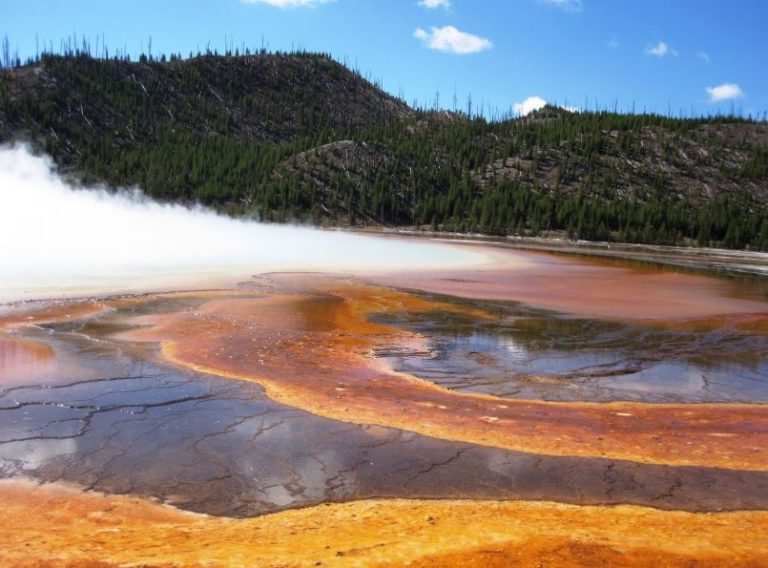Star Trek was a well-loved TV series, and Star Trek: The Motion Picture was based on this epic science-fiction story. With cosmic themes and fast truths about the nature of humankind, the film was met with a patronizing audience when it debuted in 1979.
Die-hard fans of the movie and the Star Trek franchise as a whole would love to visit the locations where the motion picture was filmed and recreate their own scenes from the film. If you want to know where the film franchise was filmed – in case you want to go there – here are the locations:
Star Trek: The Motion Picture (1979)
The first installment for the Star Trek: The Original Series motion picture was filmed in Yellowstone National Park in Wyoming. The place became the fictional planet Vulcan. Vulcan characters on Star Trek spent a lot of time here, and this setting was created using a mixture of on-location photography at Minerva Hot Springs in Yellowstone National Park and on-set.
Some of the Vulcan scenes were filmed at Paramount, where the art department had to recreate parts of Yellowstone in a large B-tank. There were minor setup miniatures on the floor of the tank before construction. The department made sure that the shadows that fell on Spock at Yellowstone could be properly recreated.
Star Trek II: The Wrath of Khan (1982)
The Cow Palace in Daly City, San Mateo County, California, served as the location for the special effects scene by the ILM animation department.
Spock’s death, which filming took three days, was filmed at the Golden Gate Park in San Francisco. The second unit shots of Spock’s coffin on the surface of the Genesis planet were filmed there.
Star Trek III: The Search for Spock (1984)
The cinematographer of the third Star Trek film, Charles Correll, suggested that Genesis be filmed on Kauai in Hawaii and Vulcan be filmed at the Red Rock Canyon. However, the production didn’t have the money to shoot on location, so the team was preoccupied with making sure the outdoor settings looked believable. They used a set wherein various vessel exteriors were handled by ILM.
The Occidental College in Los Angeles, California, served as the production’s only location shooting. The Vulcan stairs were filmed there, with modifications on the atmosphere and sky so it would look like another planet.
Star Trek IV: The Voyage Home (1986)
The Voyage Home was the first Star Trek movie to film extensively on location, in contrast to The Search for Spock, whose shooting on-site only took one day. Much of the production was filmed in and around the San Francisco Bay area in California. It was because the production wanted to film scenes that were identifiable as the city.
In the film, the Bird-of-Prey lands were concealed in Golden Gate Park, surprising sanitation workers who flee the scene in their truck. The production planned to film in the real park, but heavy rains before the shooting day prevented it. Instead, they used Will Rogers Park in western Los Angeles.
The Cetacean Institute, Dr. Gillian Taylor’s workplace, was filmed in the real-life Monterey Bay Aquarium. A holding tank for the whales was added through special effects. The scene with the Bird-of-Prey in the water and the main cast jumping into the water was filmed at Paramount’s B-Tank.
For the scenes at the planet Vulcan, the production used the Vasquez Rocks Natural Area Park in the high desert of Los Angeles.
Other locations in the movie were filmed on the USS Ranger, Oakland International Airport, Marin Headlands, and Marin Drive. Underwater photography that includes the mini whale models was filmed at a swimming pool at the College of Marin. The Oakland International Airport was used as a foreground element of the Starfleet Headquarters.
Star Trek V: The Final Frontier (1989)
The opening climbing sequences of the fifth Star Trek movie were filmed at the Yosemite National Park in California. Stunt doubles were used in filming long shots of Kirk scaling the mountain. Shatner’s closer shots had him on a fiberglass set placed in front of the camera, with the real mountains visible in the background.
After the shots at the Yosemite, location shooting moved to desert locales. Nimbus II and Paradise City were recreated in the Mojave Desert in central California. The props team used a haphazard collection of futuristic scrap and spaceship parts. Meanwhile, the Trona Pinnacles Recreation Lands in San Bernardino County, central California, was used as Sha Ka Ree. The scene where Spock catches Kirk as the captain falls off El Capitan was filmed against a set that replicated the forest floor.
Bluescreen footages of Shatner falling were then shot at Paramount and composited, while a stuntman set a record for the highest fall by plummeting off El Capitan. The stuntman used a wire support rig, and the footage was used for long shots.
Back at Paramount, the production crew filmed all scenes that would take place on soundstages like the Paradise City interiors, Bird-of-Prey sets, the Enterprise, and the campfire location.
Star Trek VI: The Undiscovered Country (1991)
The Undiscovered Country had a few notable filming locations. Some of the sequences of the Rura Penthe were filmed in northern Alaska – the first time Star Trek was filmed outside of California. Some scenes were filmed at the Knik Glacier, Valdez-Cordova Census Area, and Chugach State Park in Alaska.
The Brandeis-Bardin Institute, a religious retreat in Southern California, served as the shooting location for the internal and external shots for Camp Khitomer. Additional shots of Camp Khitomer were filmed at the Fireman’s Fund Building in Marin County.
The external shots of Rura Penthe were shot at the Bronson Caves at the Bronson Canyon, part of Griffith Park in Los Angeles, California. Meanwhile, the interior shots were taken on Paramount Stage 16.
Meanwhile, the briefing room scene of Starfleet Headquarters was filmed at the First Presbyterian Church of Hollywood.
